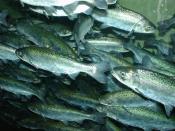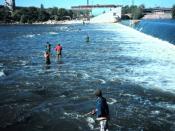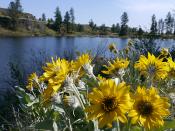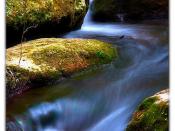Chinook salmon are on the verge of being endangered??? Yes, Chinook salmon are endangered. Early in the semester we found out that the Chinook salmon were placed on the threatened endangered list because only 250 came back this last spring. Mr. Shumway's third period class went out to the streams to see if those streams could support salmon. We went to Berthusen Park, where Bertrand creek is; the other place we went to was Lynden City Park, where Fishtrap creek is. We spent two days at each stream gathering as much information as we could include: pH, Dissolved Oxygen, Temperature, saturation percent, macroinvertebrates/water quality, velocity, and everything on the reach.
Let me start out first on why we decided to go to the stream in the first place. We went to the stream to look for all the signs that salmon could live there and be able to spawn.
We wanted to see if these streams were a problem for the Chinook. Stream conditions should match these that were found on www.psmfc.com: five or more drops for Dissolved Oxygen, a pH of 6.5-7.5, it must be fifty degrees Fahrenheit or below, a saturation of 90% or greater, good or excellent macroinvertebrates, 1-3ft velocity, 70% of native plants, needs to be almost completely shaded, needs to be a diverse stream about 1-1 riffle, and a good gravel mix for breeding.
Enough with the basic stuff and lets get into what my group's results were and if they were good or bad for salmon. We tested half at one stream and half at the other one. For dissolved oxygen and pH we tested at Lynden City Park whose stream is Fishtrap creek. We tested in two to three different places and tested each place twice. We tested in a riffle and in a calm pool. The results for the riffles we seven drops to make the liquid clear and when we tested in the calm pool we also received the result of seven drops to make the liquid clear. PH levels were the same in both places a sturdy seven. This pH and Dissolved Oxygen were both great for salmon the drops were a little over 5 drops and the pH was right in the middle of the small scale for salmon.
My group also tested the saturation, temperature, and velocity at Lynden City Park's Fishtrap Creek. Our saturation results were 100 percent they were good for salmon because saturation percent needed to be at least 90 percent or better this was said at www.educ.sfu.ca/nbcr/dissolved.html. How we found out saturation was you have a chart and match up the points. The temperature my group found was good for salmon at ten more then the recommended temperature. It was a sixty degree Fahrenheit. That makes it so salmon can spawn at the Fishtrap creek without endangering themselves to death. The next one we tested and was the last at Fishtrap creek in Lynden City Park was the velocity. We found out what velocity we needed at http://www.ce.utexas.edu/prof/ce319f/labs/Lab3Visualization/3_Visualization_Worksheet.doc. The velocity was tested by marking off a fifty feet zone and had someone at the start and the finish. The person at the finish puts the apple in the water a few feet away from the start so that it will catch the current and move with it. The person at the end will start a timer when the starter says to start the timer. Our result for this test was 2 feet per second. Salmon must have it at least one to three feet per second. This meaning it is good for the salmon.
When we went to the Berthusen Park with Bertrand Creek we checked how the reach was doing. This included: Bank cover, Overhead Canopy, and animal impact. We first checked the Bank cover which means we had to check for native plants and for any garbage and anything that could affect salmon spawning and juveniles. When we checked the bank cover we found that there were little to none nonnative plants on the bank and even less trash there. We only found one tire inside the stream. The tire was causing no problem with the stream it even looked as if it had been there for quite some time. Next we looked at the Overhead canopy which is the trees and the shading on the stream. On Bertrand Creek there were many trees and lots of cover. It also had a few sunny spots and that is it. This equaled out to it almost all being shaded which is great for keeping the streams cool and for salmons to not overheat. There was an 90 percent overall cover to the stream. The last thing we checked for was animal impact and barriers. We found almost no signs of animals being anywhere near there, but there was a bridge across the stream leading to campsites. So it is a good place for salmon. All of this information was found on www.gaiabooks.co.uk/environment/leaves.html we also found information on http://www.conservation.state.mo.us/fish/watershed/stfranc/habitat/380hctxt.htm.
Now that we have checked all the stream conditions we checked the macroinvertebrates. Macroinvertebrates are important to a stream because it will tell you how the stream's water quality is. Macroinvertebrates also tell you if the stream is polluted or not by which kind of insects are living in because some are tolerant of pollutants and some are not. Some that are intolerant were Stonefly larva and Alderflies. Most of the insects we found were in-between they were able to be in pollutants and not be able to be in pollutants meaning it was okay or fair water. This was good for salmon because if the water is good and there are insects to eat that would mean that it is good. This information was found on http://www.wrc.wa.gov.
The very last thing we tested would have to have been substrate and Fish habitat. The substrate was the easiest to test all we needed to do was make sure that there were gravel areas for salmon to lay their eggs. They need a good gravel mix for the eggs to be protected and that is exactly what we found at Bertrand Creek. The next thing we looked for was for riffles and pools to see if there were an even amount of them. For every riffle we basically found a pool to go with it making it a fifty-fifty ratio. This is good for the salmon, matter of a fact that is some of the best conditions for the salmon. This information was found on www.psmfc.org.
I have now found that in both streams The Chinook salmon can live. All of the results were good. Salmon are able to spawn and have juveniles with little to no problem. We enjoyed this experience with much pleasure because one it got us out of class and two we all want to try to help something come back to life. Many things that humans can fix such as do not litter, use your car less and car pool with someone, heck and you can always go and clean up a stream near you. Salmon have just as much as a right to live as we do so treat them like you would want to be treated. Another thing is to always ask yourself before you throw that wrapper out the car window if you would want someone throwing a trash in your home. With the Bertrand and the Fish trap creek being kept as clean as they are will ensure that, at least some, Chinook salmon will be back to continue their life cycle.
References: http://www.gunderboom.com/oxygen.html Dissolved Oxygen http://www.dnr.cornell.edu/sarep/Kids/experiments/sampling/pH.html Ph http://h2osparc.wq.ncsu.edu/river/salmon/etemp.html Temperature www.gaiabooks.co.uk/environment/leaves.html Overhead Canopy http://www.wrc.wa.gov.au/public/waterfacts/2_macro/WF2.pdf Micro invertebrates water quality rating http://www.conservation.state.mo.us/fish/watershed/stfranc/habitat/380hctxt.htm Bank Cover-John Fantz & Matt Matheney http://www.krisweb.com/stream/sediment.htm Substrate http://www.ce.utexas.edu/prof/ce319f/labs/Lab3Visualization/3_Visualization_Worksheet.doc Velocity www.psmfc.org Saturation Bank cover Animal impact and barriers




